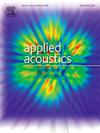基于声到达结构的深海少射源距离估计
IF 3.4
2区 物理与天体物理
Q1 ACOUSTICS
引用次数: 0
摘要
理论分析表明,震源距离的变化会引起深时域声到达结构的显著差异。因此,本文首次提出以声场的到达结构作为输入特征,从图像识别的角度出发,采用二维卷积神经网络(2D-CNN)进行水声声源定位。为了解决观测数据有限的源距离估计问题,构建了迁移学习模型。在利用声传播模型生成的模拟数据进行预训练的基础上,利用探测区域的小样本观测声数据对模型进行进一步训练。通过灵敏度分析,研究了环境参数不匹配对源定位的影响。仿真结果表明,与传统的匹配场处理方法相比,该方法具有更好的性能和更强的鲁棒性。南海实验结果表明,与传统的匹配场处理(MFP)和2D-CNN方法相比,该方法的定位性能要好得多。对于距离预测,对于30公里以内的源,平均绝对百分比误差(MAPE)小于5%。本文章由计算机程序翻译,如有差异,请以英文原文为准。
Few-shot source range estimation based on acoustic arrival structures in deep sea
Theoretical analysis indicates that variations in source range cause significant differences in acoustic arrival structures in the depth-time domain. Therefore, this paper proposes for the first time to use the arrival structure of the acoustic field as input features and to employ a two-dimensional convolutional neural network (2D-CNN) for underwater acoustic source localization from an image recognition perspective. To address the source range estimation with limited observed data, a transfer learning model is constructed. Based on pre-training with simulated data generated by the acoustic propagation model, the model is further trained on small-sample observed acoustic data from the detection area. Through sensitivity analysis, the impact of mismatched environmental parameters on source localization is investigated. Simulation results demonstrate that the proposed method exhibits superior performance and stronger robustness compared to traditional matched-field processing. Experimental results from the South China Sea show that the localization performance is much better compared to the conventional matched field processing (MFP) and the 2D-CNN method. For range predictions, the mean absolute percentage error (MAPE) is less than 5 % for the source up to 30 km.
求助全文
通过发布文献求助,成功后即可免费获取论文全文。
去求助
来源期刊

Applied Acoustics
物理-声学
CiteScore
7.40
自引率
11.80%
发文量
618
审稿时长
7.5 months
期刊介绍:
Since its launch in 1968, Applied Acoustics has been publishing high quality research papers providing state-of-the-art coverage of research findings for engineers and scientists involved in applications of acoustics in the widest sense.
Applied Acoustics looks not only at recent developments in the understanding of acoustics but also at ways of exploiting that understanding. The Journal aims to encourage the exchange of practical experience through publication and in so doing creates a fund of technological information that can be used for solving related problems. The presentation of information in graphical or tabular form is especially encouraged. If a report of a mathematical development is a necessary part of a paper it is important to ensure that it is there only as an integral part of a practical solution to a problem and is supported by data. Applied Acoustics encourages the exchange of practical experience in the following ways: • Complete Papers • Short Technical Notes • Review Articles; and thereby provides a wealth of technological information that can be used to solve related problems.
Manuscripts that address all fields of applications of acoustics ranging from medicine and NDT to the environment and buildings are welcome.
 求助内容:
求助内容: 应助结果提醒方式:
应助结果提醒方式:


